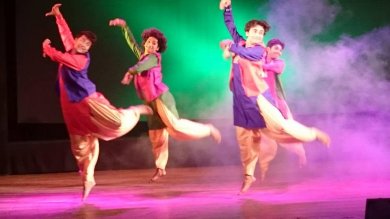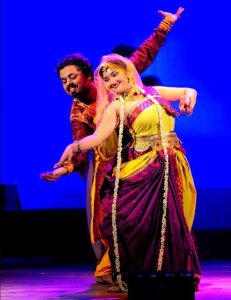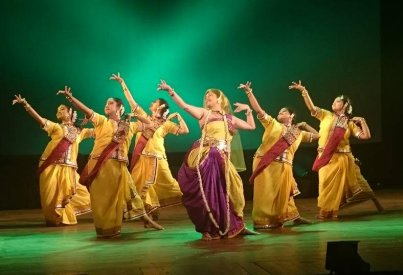
|   |

|   |
Sankalpa by Nrittyoday - Nita Vidyarthi e-mail: nitavidyarthi@gmail.com Photos courtesy: Nrittoday September 9, 2015 Two enterprising friends Bidhan Roy Chowdhury and Pradyumna Mukherjee, both dancers, had a dream to take up the challenge to walk in search of divinity and truth of being a human being through dance and music by training young dancers and children in their two-year old dance school Nrittyoday. Their aim was to begin with a classical set up and gradually deconstruct the formal presentation in the course of their journey to an informal one. This idea was reflected in ‘Sankalpa,’ their second annual presentation of dance held recently by the members of Nrittyoday, at the Gyan Manch based on Uday Shankar Dance Form and Bharatanatyam. A creative initiative, the program reflected the dedication of Bidhan, a disciple of Anita Mallick and Mamata Shankar as a teacher and performer, as well as the organizing capability of Pradyumna. The assorted fare before the main production ‘Kalon... Journey to Sambid’ consisted of short enjoyable items by beginners, young enthusiastic learners and trained dancers, all on one platform. All the items were choreographed by Bidhan.  Jhir jhir batase The evening began with a well-rehearsed pure Bharatanatyam item ‘Mallari’ based on ragam Nattai and talam tisra dhruvam, by young learners followed by the felicitation of the actor- Bharatanatyam dancer Jaya Seal Ghosh, the president of the organization. The Rabindrasangeet “Aloker ei jharnadharaye” saw a vibrant presentation by all the students and members of Nrittyoday including Pradyumna and Bidhan. Bidhan’s choreography set to pre-recorded vocal support by Sreekanta Acharya and Swagatalaxmi Dasgupta reflected the Uday Shankar style in the hand movements, mudras as well as the stances. The joy of childhood was displayed by the junior-most members in Rupankar’s song “Pahar mati stoop” and “Aye re aye” sung by Manomoy. The simple yet innovative white blobbed slanted tops on black tights were a perfect choice for the costumes of these happy little girls. The best item of the evening was the exciting all male number “Ei jhir jhir batase” set to Srikanta Acharya’s song and performed with felicity and youthful exuberance by Saikat, Tathagata, Sayan and Pradyumna. This song of the golden era of Bangla Adhunik (Bengali modern songs) has hardly been choreographed and Bidhan must be appreciated for choosing this number adorned with stretched movements and fascinating jumps. “Ke aabar bajaye banshi” by the senior girls lost its appeal after the previous item.  Kalon The dance drama ‘Kalon’ was based on the philosophical thoughts of Rabindranath Tagore pursuing the idea of the ‘knowledge within’, through different manifestations of love, joy and affection witnessing the “Leela of Paramatma” while exploring the inner and outer battles of characters, the humans and the godly veiled by ‘maya” (illusion). Tagore’s idea of Jeevatma-Paramata was not distinctly portrayed even though the theme traced the journey of a human being veiled in maya (Sthula Manav) from the materialistic world to the spiritual plane as Suksha Manav with the help of “sambid” (consciousness). The pathway is through one’s soul, the atma, to reach the spiritual plane that is moksha (salvation). Directed by Bidhan Roy Chowdhury and scripted by Sayak Mitra, the ambitious presentation uses appropriate selection of Rabindrasangeet that stresses the underlying nuances by Srikanta Acharya, Sraboni Sen, Lopamudra Mitra, Sounak Chatterjee, and Jayati Chakravarty, weaving pleasing movements into a collage following the cycle of seasons which reflected and also painted metaphorically the different stages of a man’s life to reach the ultimate. Thus beginning with spring “Basanti hey,” “Timir abogunthaney” in monsoon and others including “Mohini maya elo” from Tagore’s dance-drama ‘Mayar Khela,’ the story of movements embracing classical and Uday Shankar’s vocabulary led to an interesting composition. The music by Bikram Ghosh, Shivamani and Sayak Mitra was pleasing as was the recitation by Dibyendu, Sayak and Manjeera.  Sreeparna and Bidhan Sreeparna Chatterjee is a good dancer and as Maya, justified her role and as Manab, Bidhan was convincing. If only he could wear a smile on his otherwise expressive face during romantic scenes! A bit of re-thinking of the presentation would avoid crowding with too many dancers at a time on the limited performance space avoiding too much floor walks and criss-crossings as in the first scene and make the performance more integrated.  Also an excess of blue light smeared with too much smoke pumped in to enhance the effect of illusion or Maya, clouded vision and the movements of the otherwise good dancers. The finale was apt and profoundly gratifying with the dancers in white walking slowly with lighted diyas showing the eternal divine path with the sense of spirituality in the number “Gatistyam Gatisyam thyameka Bhavani.” Nrittyoday’s attempt is otherwise praiseworthy. Dr. Nita Vidyarthi is a critic of performing arts, specialising in dance, dance theatre and expressions and is a regular contributor to The Hindu, and the Statesman Kolkata in dance, vocal music and theatre. She is trained in Kathak, Bharatanatyam and Manipuri as well as vocal, semi-classical music and Rabindra Sangeet. A Science communicator, Ph.D. in Polymer Science, Commonwealth Scholar and a retired Professor of Chemistry, Nita devotes most of her time to dance and theatre writing. |